In the world of music, there is a guitar scale that holds great power & versatility. It is known as the pentatonic scale. Comprised of 5 notes per octave, this scale has found its way into various genres, from blues to rock to pop. Its simplicity and adaptability have made it a crucial component in the world of guitar playing. Today, we dive into the A Major Pentatonic Scale, exploring its theory & learning how to master it on the guitar.
Whether you’re a beginner searching for new knowledge or a seasoned guitarist yearning for a fresh perspective, this article will provide you with the groundwork needed to infuse the A Major Pentatonic into your musical repertoire.

Overview of The Major Pentatonic Scale
The Major Pentatonic Scale is a versatile musical scale consisting of five notes, derived from the diatonic major scale by removing two notes.
Its structure follows a specific pattern of intervals, resulting in a simplified & versatile arrangement. This scale is widely used in various musical genres and cultures, offering a pleasant & harmonious sound due to its absence of dissonant intervals.
Its simplicity makes it accessible to musicians of all levels, and its neutral tonality allows for easy transposition to different keys. The absence of half-steps enhances its melodic resilience, making it universally appealing across various music genres.
Music Theory of The A Major Pentatonic Scale
The A Major Pentatonic Scale is a musical theory that consists of 5 notes: A (Root Note), B, C#, E, and F#
These major pentatonic notes are derived from the A Major diatonic scale by omitting the 4th and 7th degrees. The intervals between the notes in the A Major Pentatonic Scale follow a specific pattern: whole step, whole step, minor third, whole step.
To play the A Major Pentatonic Scale in the first position, you can use the following scale shape: 5th fret of the low E string (A, Root Note), 2nd fret of the A string (B), 4th fret of the A string (C#), 2nd fret of the D string (E), and 4th fret of the D string (F#).
This is just 1 of 5 scale shapes which can be played individually. These different positions enable fluid movement and flexibility, allowing guitarists to incorporate the A Major Pentatonic Scale into their improvisations & compositions with ease.
How To Play The A Major Pentatonic Scale In 5 Positions
Position 1
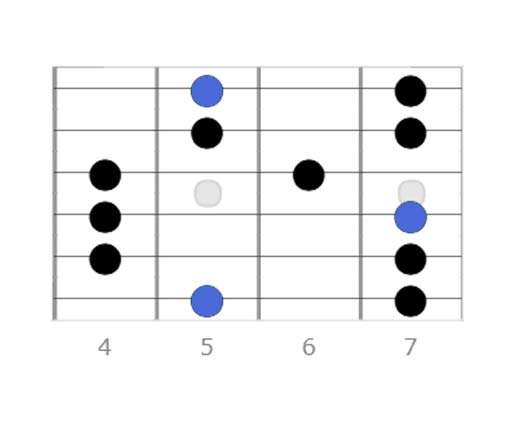
Position 2
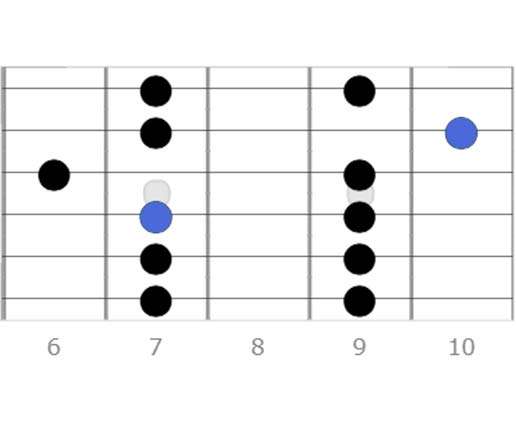
Position 3
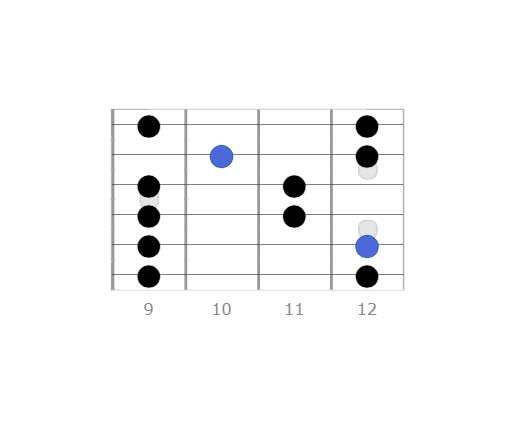
Position 4
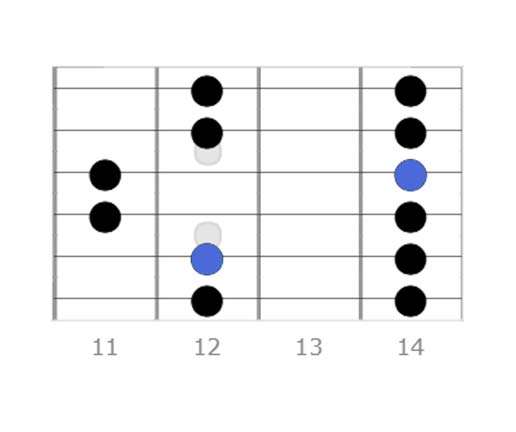
Position 5
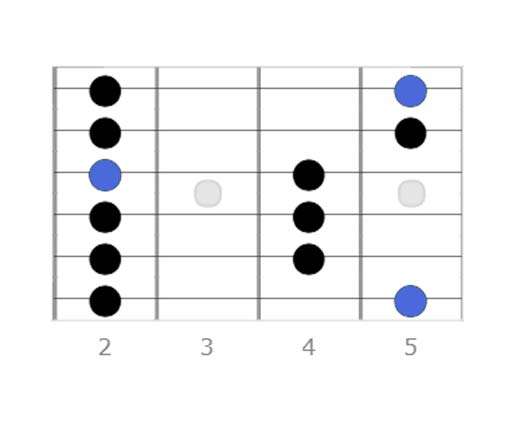
A Major Pentatonic Scale Across The Full Fretboard
This is what all of the scale shapes look like when they are connected together. This is helpful to visualize it overall, and if you want to play the A Major Pentatonic Scale lengthwise across 1 or a couple of strings.

The Minor Pentatonic Scale
The construction and tonal character of the minor pentatonic scale differ from those of the major pentatonic scale. While both scales have five notes per octave, the minor pentatonic is built on the root note, minor third, perfect fourth, perfect fifth, and minor seventh intervals, giving the minor pentatonic scale a minor tonality & a distinct sense of melancholy or bluesy quality.
The major pentatonic scale, on the other hand, is composed of the root note, major second, major third, perfect fifth, and major sixth intervals, producing a more uplifting and brighter sound.
Relative Minor Pentatonic Scales
The relationship between the major pentatonic scale & its minor counterpart lies in their shared notes. They are relative scales, meaning they have the same notes but begin on different tonics.
For example, the A major pentatonic scale (A, B, C#, E, F#) shares the same notes as the F# minor pentatonic (F#, A, B, C#, E). So F# minor pentatonic is the relative minor to A Major pentatonic.
Understanding the relationship between these scales allows musicians to seamlessly transition between them, providing a fluid & versatile musical expression.
Popular Songs That Use The Pentatonic Scale
Several popular songs make use of the pentatonic scale, showcasing its widespread appeal and versatility in different music genres:
Smoke on the Water” by Deep Purple – This iconic rock riff is based on the pentatonic scale and is one of the most recognizable guitar melodies in rock music history.
Sweet Home Alabama” by Lynyrd Skynyrd – This Southern rock anthem features a memorable pentatonic guitar riff that has become a classic in the genre.
“Johnny B. Goode” by Chuck Berry – A rock and roll classic, this song’s main riff is based on the pentatonic scale, contributing to its timeless appeal and influence on rock music.
“Kashmir” by Led Zeppelin – This rock masterpiece uses the pentatonic scale to create an epic and mystical atmosphere in its iconic guitar riff.
Frequently Asked Questions
What notes are in an A major pentatonic scale?
The notes in an A major pentatonic scale are A – B – C# – E – F#
What is the difference between a minor pentatonic & a major pentatonic scale?
The only difference between a minor pentatonic and a major pentatonic scale lies in their structure and tonality. The minor pentatonic scale is derived from the natural minor scale and contains a flatted third and seventh degree, resulting in a darker and bluesy sound.
In contrast, the major pentatonic scale is derived from the major diatonic scale and features a major third and seventh degree, creating a brighter and more uplifting character. Both scales consist of 5 notes and are widely used in various musical genres, but their distinct intervals give them unique and recognizable tonal qualities.
What is the difference between the A scale & A pentatonic scale?
Assuming you’re talking about Majors, the main difference between the A major scale and the A major pentatonic scale lies in their note structures.
The A major scale consists of seven notes: A, B, C#, D, E, F#, and G#. This scale encompasses a broader range of notes, allowing for a more intricate and harmonically rich sound in various musical contexts.
On the other hand, the A major pentatonic scale is a simplified version of the A major scale, containing only five notes: A, B, C#, E, and F#. It is formed by removing the 4th and 7th degrees of the major scale.
This reduction results in a more straightforward and accessible tonal palette, making it popular in genres like country, folk, and rock music. The pentatonic scale’s streamlined structure lends itself to easy melodic improvisation and enables musicians to create catchy and memorable hooks & riffs.
What are the two types of pentatonic scale?
The two types of pentatonic scales are the major and minor pentatonic scales.
Major Pentatonic Scale: The major pentatonic scale is a five-note scale derived from the diatonic major scale by removing the 4th and 7th degrees. It has a bright and cheerful tonality, making it well-suited for creating uplifting melodies. The major pentatonic scale is commonly used in various music genres, including country, pop, and folk, due to its simplicity and versatility.
Minor Pentatonic Scale: The minor pentatonic is another five-note scale derived from the natural minor scale by omitting the 2nd and 6th degrees. It has a more somber and bluesy sound, making it a fundamental element in blues, rock, and jazz music. The minor pentatonic allows for expressive and emotive melodies, making it a popular scale for guitar solos and improvisations.
What scale is used for blues?
There are 3 scales most commonly associated with blues. They are the minor pentatonic scale, the major pentatonic scale, and the blues scale itself.
The minor pentatonic scale, with its soulful and bluesy character, forms the core of many blues melodies and improvisations.
The major pentatonic scale, with its brighter tonality, adds a touch of optimism and versatility to blues music.
The blues scale, a six-note scale derived from the minor pentatonic scale, incorporates the “blue notes,” infusing the music with its distinct and expressive flair.
Together, these three scales can provide a rich & diverse harmonic foundation for blues musicians to convey raw emotions and tell captivating stories through their playing.
Is pentatonic scale same as blues?
No, the pentatonic scale is not the same as the blues scale, though the blues scale is built on the pentatonic scale. The pentatonic scale consists of five notes with a major or minor tonality, whereas the blues scale consists of six notes with an additional chromatic note known as the “blue note.”
The blue note is responsible for the blues scale’s distinct & emotive sound, which is characteristic of blues music. While both scales are commonly used in blues music, the blues scale adds the distinct color and soulful quality that defines the genre’s distinct essence.
